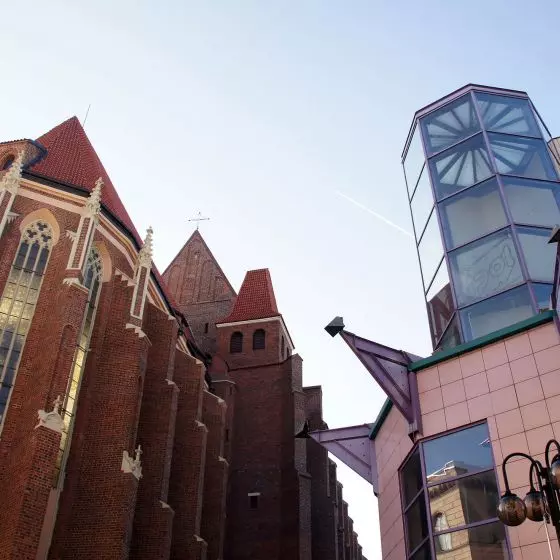In the center of Lodz, at 81 Kosciuszki Street, sixteen meters of panels covered with ivy have been erected on the building of the Municipal Kindergarten No. 75. The city is betting on green walls, introducing a new tool for greening cities.
ivy on the panels
The Department of Ecology and Climate of Lodz City Hall has erected a pilot installation - a green wall- in the center of the city. The 16-meter structure overgrown with ivy is to serve as leaven for covering the entire wall of the building.
In the era of climate change and the need to counteract its negative effects, we need to look for more and more new and new solutions to support our efforts. Of course, one green wall won't solve the problem, but this is only the beginning of long-term plans. At the same time, we also hope that when residents, entrepreneurs see what it looks like, and contrary to rumors, it does not damage buildings at all, they will follow our example," says Maciej Riemer, director of the Department of Ecology and Climate of the City of Lodz.
what advantages do green walls have?
The department refers to the experience of Professor Stanley White of the University of Illinois, who designed the first green wall in 1938. This solution has been used successfully all over the world, not only for public buildings, but also for domestic users.
Common ivy is the most common plant on green walls
© City Hall of Lodz
What advantages does this solution have? One square meter of green wall absorbs 2.3 kilograms of carbon dioxide per year and produces 1.7 kilograms of oxygen. The ivy on the panels absorbs 50 percent of the light, making the green wall reduce the temperature in its surroundings by about three degrees Celsius. The green wall is also said to be sound-absorbing and reduce noise inside and outside the building on which it is placed. It reduces noise by about eight decibels. The ivy is expected to have a positive effect on the city's microclimate, including by absorbing rainwater.
Officials also boast about the price - the cost of the sixteen-meter-long urban green wall at 81 Kosciuszko Street was less than fourteen thousand zlotys.
Are green walls "greenwashing"?
Landscape architect Joanna Rayss of Rayss Group talks about whether to use green walls and how to design them.
Wiktor Bochenek: Are green walls greenwashing?
Joanna Rayss: Whether something is greenwashing always depends on the way it is designed and implemented, the size of the outlay and the proportion to it of the planned effects. Therefore, especially in the case of simple, very low-cost green wall solutions in the form of vines, I would avoid assuming in advance, green walls are greenwashing. Although yes, overinvested and improperly executed so-called " system green walls" can have a disproportionately small ecological impact to the financial outlay and maintenance costs, including huge water consumption. However, I think this does not apply to green walls in the form of climbing plants, which are traditional in our climate.
Wiktor Bochenek: Where and when to introduce green walls?
Joanna Rayss: From a natural point of view, green walls work best where there is no room for trees. They do not require a lot of space, plus they have a good effect on the well-being of the building.
A green wall in Lodz at Kosciuszko Street
© City Hall of Lodz
Wiktor Bochenek: Thereis often anopinion that such green walls and climbing plants will harm the building.
Joanna Rayss: This is not true. If the facade is done properly - without cavities and cracks then a climbing plant will not harm it, provided that we choose the climber well. Often foreign species can indeed be aggressive. If you select native species, such as common ivy(Hedera helix), you will not have this problem. This species uses suckers to climb, which do not penetrate the object they are climbing on. Such an additional quilt of evergreen ivy leaves, on the other hand, reduces the temperature amplitude at the facade which actually protects the facade material from damage. Because it is the drastic changes in temperature, especially day-night that harm the façade the most.
However, if someone is afraid of introducing vines directly to the facade, it is always possible to use vines that climb with the help of so-called " mustaches " and introduce them using an appropriate substructure, such as in the form of steel cables. This is a solution that allows you to create a green wall not directly adjacent to the building with all the advantages of climbing plants.
Wiktor Bochenek: Thank you for the interview!
another tool of local government officials, entrepreneurs and architects
Supporting the development of green walls was started a few months ago by Kalisz, which instead of putting up new walls exempts them from property taxes. We also talked about how to arrange urban greenery with landscape architect Joanna Rayss. Green ivy walls, although they are often seen in our cities for years on historic buildings, also appear in modern architecture, such as in Milan's Bosco Verticale designed by Boeri Studio or Singapore, where the largest green wall in the world was created. The introduction of green walls does not always require great financial outlays, and in the long term can bring a positive effect.





















